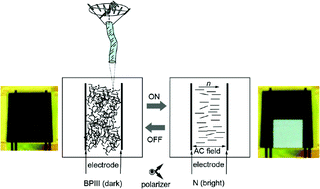Material design for blue phase liquid crystals and their electro-optical effects
Abstract
Liquid-crystalline blue phases have attracted a considerable amount of attention because of their hierarchical phase structures with optical isotropy and because of their application to electro-optical devices. The driving forces for the frustrated liquid-crystalline phases differ from those for a conventional liquid-crystalline phase composed of rod-like molecules. Classical molecular design is inapplicable to blue phase liquid crystals. From perspectives of display applications, blue phases exhibit some revolutionary features. They obviate surface alignment, and provide submillisecond response time and an isotropic dark state. Nevertheless, critical problems remain, such as high driving voltage and hysteresis in the voltage–transmittance curve. After reviewing recent progress in stabilizing blue phases, we describe their electro-optical performance. Some advanced concepts in material design widen the blue phase temperature range. Furthermore, development of materials and device structures have prepared blue phase LCD for use in next-generation liquid-crystal displays. Blue phases are no longer a special liquid crystal exhibiting an extremely narrow temperature range.


 Please wait while we load your content...
Please wait while we load your content...